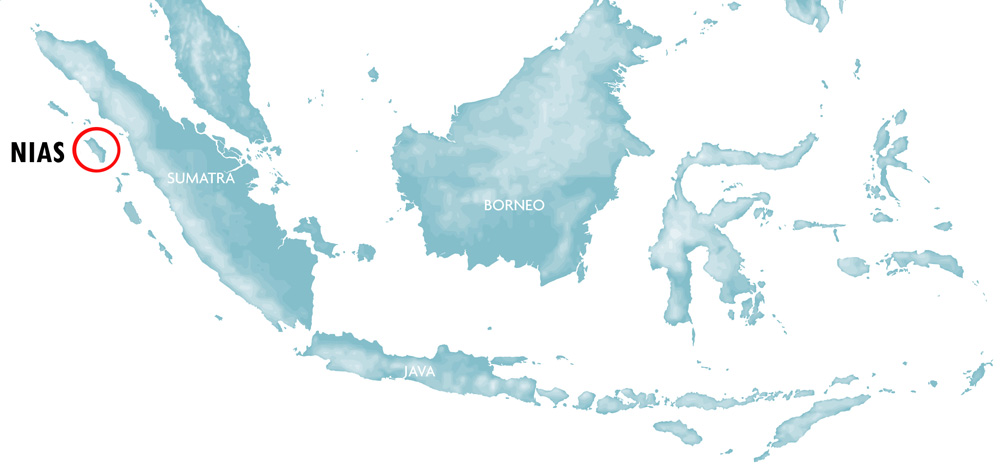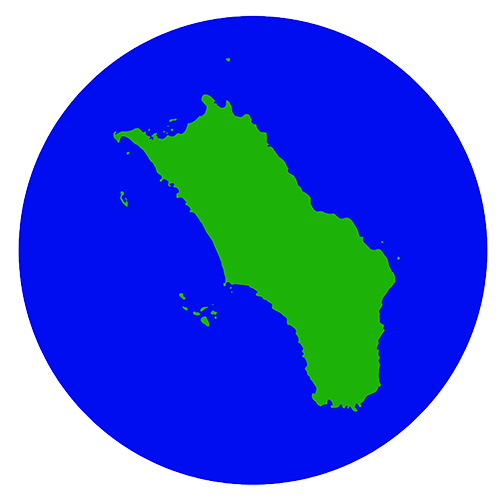Nias Culture
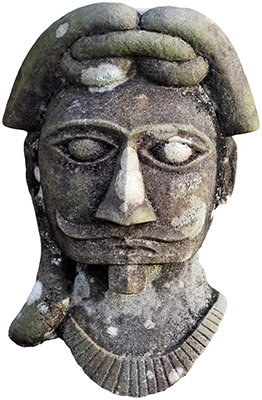 Nias Island is home to an ancient culture, distinctly different from the rest of Indonesia. The Island is famous in Indonesia for its megalith stones, traditional houses and unique cultural practices. Due to the remoteness of the island and the fierceness of its population, most Nias people lived a traditional lifestyle until the Dutch established control of the whole island in 1914. Nias was one of the last islands in the Indonesian archipelago to be brought under full colonial control.
Nias Island is home to an ancient culture, distinctly different from the rest of Indonesia. The Island is famous in Indonesia for its megalith stones, traditional houses and unique cultural practices. Due to the remoteness of the island and the fierceness of its population, most Nias people lived a traditional lifestyle until the Dutch established control of the whole island in 1914. Nias was one of the last islands in the Indonesian archipelago to be brought under full colonial control.
Nias was a strictly hierarchical warrior society, ruled by powerful chieftains. Life was dominated by traditional rituals, customary law and fighting. The island was never united under one king; instead a number of local chieftains ruled smaller fiefdoms. What united Nias people was their common language, traditions and belief system. Regional variations existed, such as different dialects and architecture, but on the whole inhabitants considered themselves one people sharing the same origins and culture. Nias people call themselves Ono Niha (the children of human beings) and their island home is called Tanö Niha (the land of the people).
Many unique aspects of Nias culture can be experienced to this day, while others (such as headhunting) are no longer practiced.
Traditional houses
Many researchers agree that Nias traditional houses (Omo Hada) are some of the finest examples of vernacular architecture in Asia. They are built without the use of nails and are able to withstand powerful earthquakes far better than modern houses. There are variations in architecture across the island; North Nias houses are free standing and round in shape, while South Nias houses are rectangular and built next to each other. In some villages there are large Omo Zebua houses, which is where the chief used to live. Nias houses are elevated from the ground and are built for defence, as Nias people used to live in perpetual warfare. Architects and anthropologists from all over the world have visited Nias to study the unique Omo Hada building style. Many older Niasans were born in houses like these, but the cost and effort of maintaining a traditional house means that they are becoming increasingly rare. Visitors can see many examples of traditional houses across the island, particularly in the south where some very well maintained villages can be seen. Some of the best preserved villages have been nominated for world heritage listing.
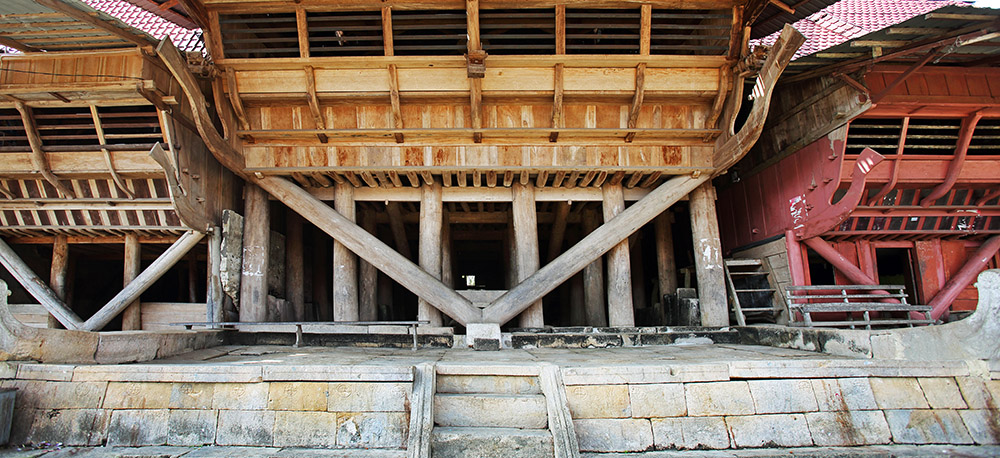
Omo Zebua – the traditional house of a chief, in Hilimondregeraya village, South Nias.
Megaliths
Megaliths of various sizes and styles are a unique aspect of Nias culture which can be found all over the Island. They were erected during important events, such as the inauguration of a new village or the wedding of a noble couple. Often different configurations of smaller megaliths can be seen in front of private houses. Larger megaliths with elaborate carvings can be found across the interior, usually marking the centre point of a village. One hundred years ago, Nias Island was one of the few remaining active Megalithic cultures in existence anywhere. Many examples of this megalithic culture can be seen across the island. One of the best examples can be found in the Gomo area in South Nias.
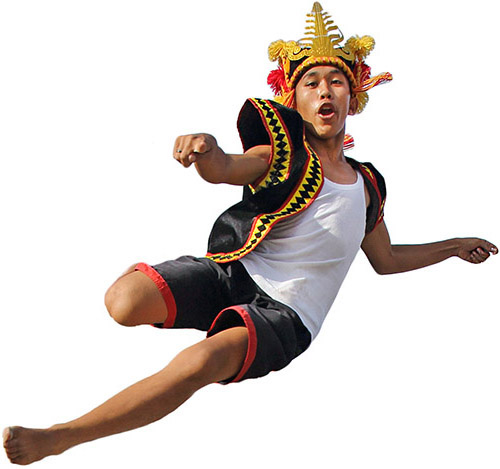 Stone jumping
Stone jumping
Stone jumping (Hombo batu) is a cultural practise unique to Nias. It is well known by Indonesians because a Nias stone jumper was depicted on the old 1000 rupiah notes. Originally the stone jumping ceremony was part of an initiation rite for young men to be accepted as adults and warriors. The height of the stone pyramids is between 1.8 meters to 2.2 meters. The jump is done barefoot and a lot of practice is required before a jump is attempted. The skill of jumping over high objects was developed as fighting technique. In a surprise attack, warriors could jump over the defensive wall of enemy villages. Many villages in the south still have stone structures for this ceremony.
The most famous can be seen in Bawömataluo village in South Nias, where a team off young men regularly perform the stone jump for visitors.
War Dance
Nias war dances (Fate’ele) are an incredible and somewhat scary spectacle to behold. Today the dances are re-enactments of past battles and fighting techniques. In the past dances were performed before battle as a way to enhance the spirit of the ancestors and for warriors to psych themselves up for mortal combat. Men of all ages participate in the dances and full tribal war regalia are worn. Typically a warrior is armed with a spear, a sword and a shield. Senior figures may wear bark clothes or metal vests and some pretty outlandish headgear. Dances are accompanied by the sound of war cries, the rattling of shields and pounding of feet. High jumps, mock fighting and scary expressions are part of the performance.
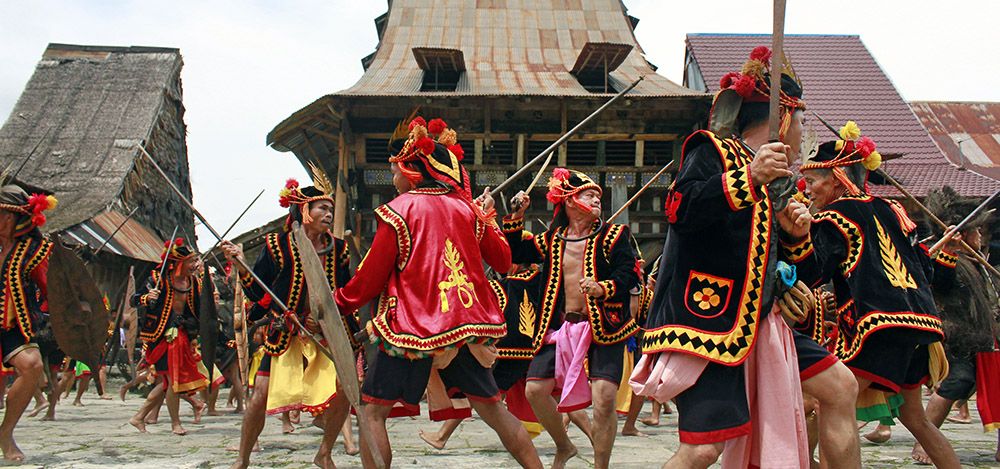
War dance in Bawomataluo village, South Nias.
Several traditional villages in the south have cultural groups that regularly practice war dances but these days they are only performed on very special occasions.
Nias Traditional Dances
Traditional dances are often performed during official events or welcome ceremonies on Nias. Fierce war dances are performed by men, while dances like the Maina and Moyo have both male and female participants. The Maina is the best known dance and it is often performed during events. There are many different variations of the Maina. For example a wedding party may be welcomed by their hosts with a Maina Fangowi (welcome dance), and the guests respond with a Maena Tome (guests arriving dance). There are many more dances for specific ceremonies and situations. The Moyo dance imitates the flight of an eagle and is often performed by women.
Nias Musical Instruments
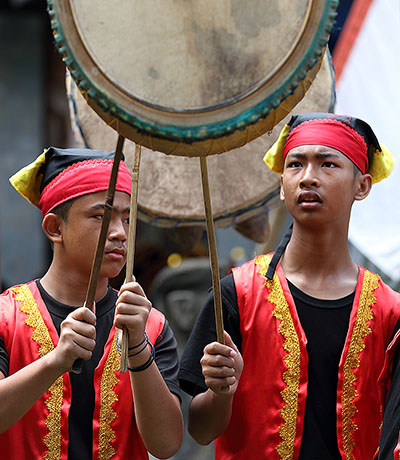
Gondra – giant drums
Ceremonies and events are always accompanied by traditional music played on instruments that in some cases are unique to Nias. The most important are the brass gongs (Aramba) and the giant drums (Gondra). If you are ever invited to a wedding you will hear the sound of the drums and the gongs at the beginning of the ceremony as important guests arrive. Another typical Nias instrument is the wooden xylophones (Doli-Doli) and a strange instrument made from bamboo (Tutuhao), which is unique for Nias. Many kids on Nias grow up playing the Koroco, which resembles a Ukuele. The most unique music on Nias is played on rocks. Stones are carefully selected for the sound they make when hit with a stick. The rocks are then lined up, often on stone tables in traditional villages and played like percussion. This produces a strange yet surprisingly melodious sound.
Nias colours and patterns
The colours of Nias are red, yellow and black. Red represents blood (clan and bravery), Yellow stands for gold (wealth and success) and black is earth (fertile soil and homeland). Traditional dancers use combinations of these three colours in their dresses, and there are many different combinations. Women from the south wear predominantly yellow, while northern ladies lean towards red. Traditional dresses always incorporate a particular design pattern. This is the row of triangles, called ‘Ni’ohaluyo’. The triangle shapes resemble spear tips and the Ni’ohaluyo pattern symbolizes the spirit of heroism in Nias people. This pattern is not only found in ceremonial dresses, they can be seen on the edges of traditional houses and on weapons. Today these colours and pattern is used for anything representing Nias, from sports to politics. If you look for it you will see it all around you wherever you go on Nias.
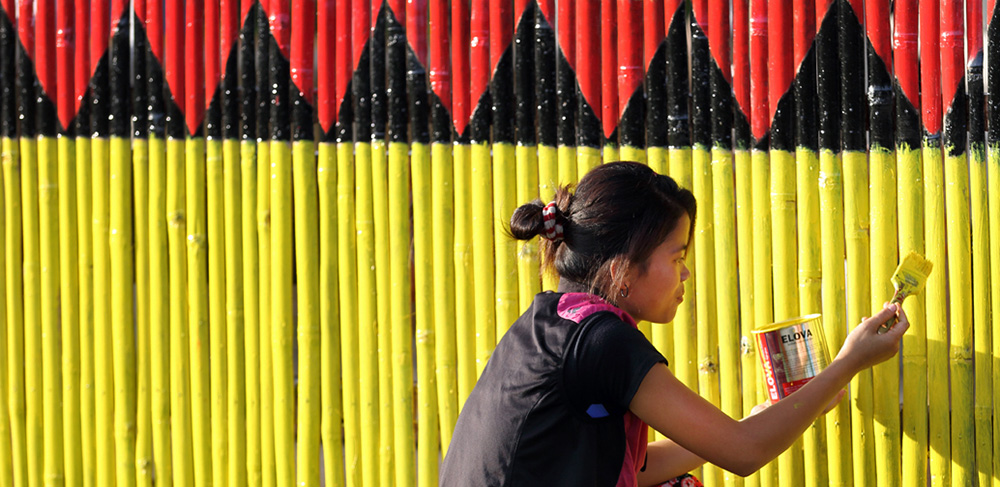
Iconic ‘Ni’ohaluyo’ pattern with the colors red, yellow and black represents Nias.
Pigs
Pigs play an important role in Nias culture. No important event can take place without the slaughter of pigs and the number of pigs slaughtered at any given ceremony directly correlates with the importance of the event and the people involved. In the past, hundreds of pigs would be slaughtered during noble weddings. Even today a family may slaughter 5-10 pigs during a wedding, depending on their wealth. Many Nias families still breed pigs selling some for profit, but most will be used for ceremonies. The sharing, serving and eating of pork follows a strict cultural protocol followed to this day.
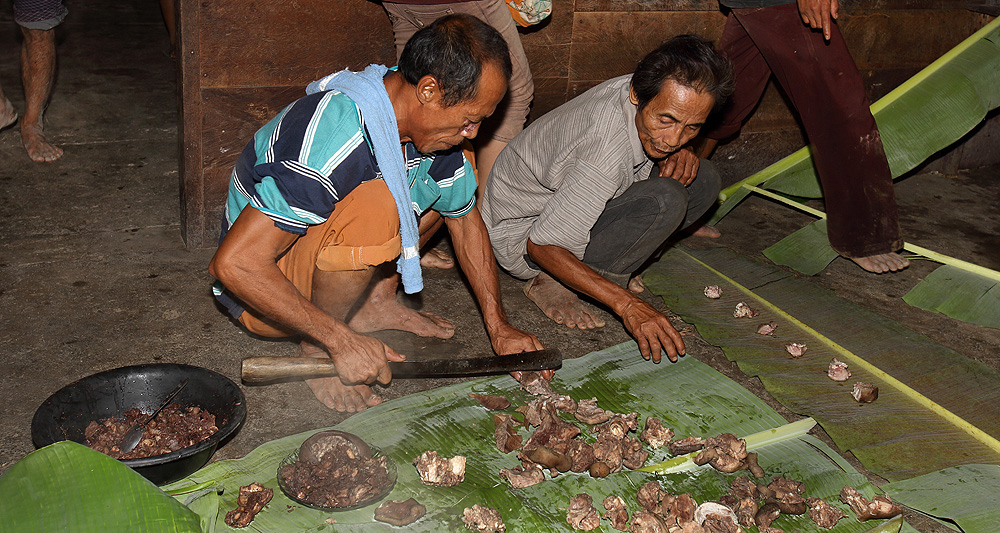
Pork meat is shared amongst villagers according to a traditional protocol in use to this day.
Graves
Burial sites of ancestors take a prominent place in front of or beside Nias houses. This is an ancient Nias tradition which is being practiced to this day by the Christian majority on the island. Visitors to Nias will notice that many houses along the road have graves with ornate stones in front of them. Important and wealthy people may even have a small house built specifically for their graves. When a person dies, there is a burial ceremony. The building and unveiling of the stone may take place long time after this, even years. This ceremony takes place when the family have saved enough money for the elaborate graves stone and when all the children can be present. This tradition is practiced all over Nias.
Previously the Nias custom was to place the corpse on a high platform or other elevated positions. After two or three weeks the head of the corpse was taken off, cleaned and placed in skull coffin near the house. Some of these skull coffins are still in use in the Gomo region. The corpses of common people were sometimes left hanging in a tree latched to a simple bamboo chair. In 1908 the Dutch colonial administrators ordered that Nias people should bury the bodies of deceased people in the ground.
Today Nias culture is kept alive by the use of Nias language, which is still used by most people on a daily basis. Even though Nias people today dress and live their lives like most other Indonesians, there are many local customs and traditions that are still observed, particularly during weddings, births and funerals. Traditional dance and music performances are often put on during important events.
A visit to the Museum Pusaka Nias (Nias Heritage Museum) in Gunungsitoli is a must for anyone coming Nias Island. This is one of the best cultural heritage museums in Indonesia and gives visitors a very good introduction to Nias culture.



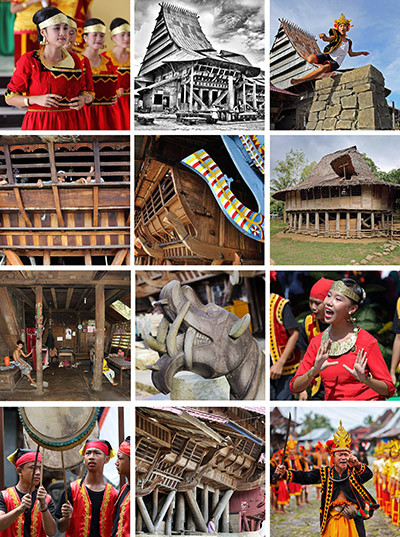
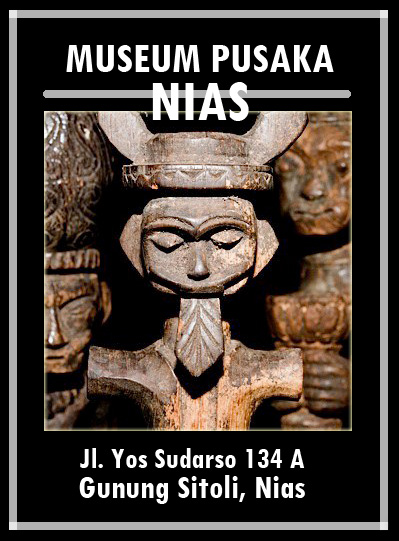
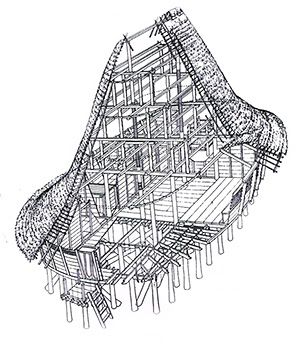 Omo Hada Northern style
Omo Hada Northern style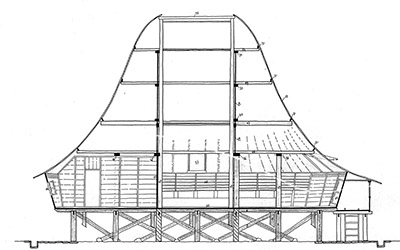 Omo Hada Northern style
Omo Hada Northern style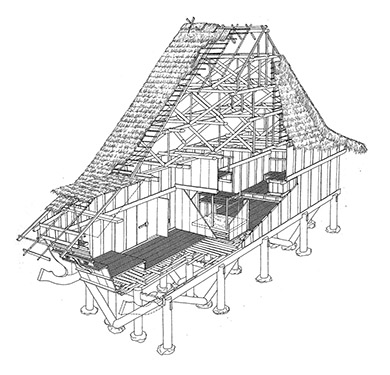 Omo Hada Central Nias style
Omo Hada Central Nias style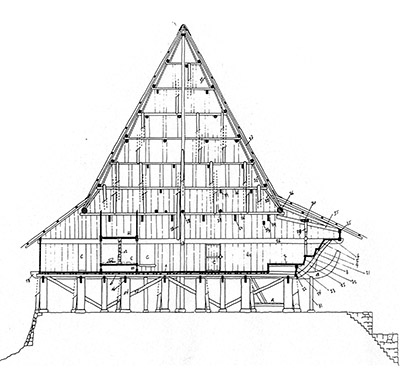
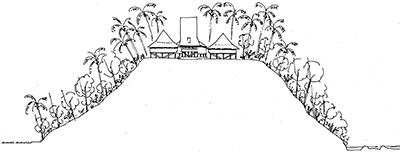
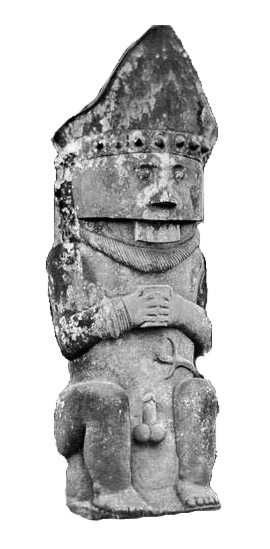 Gowe Hiligoe - Sisarahili Village, West Nias
Gowe Hiligoe - Sisarahili Village, West Nias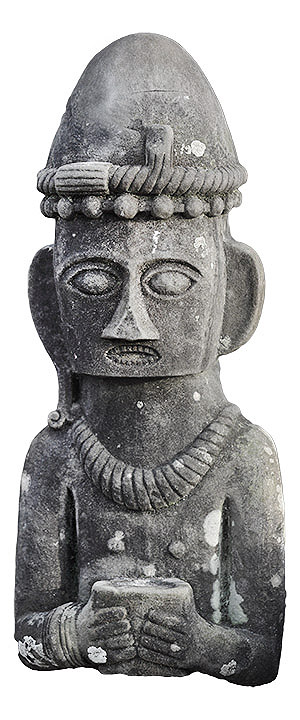 Gowe Ni'oniha - Olayama style, Bawömataluo, South Nias
Gowe Ni'oniha - Olayama style, Bawömataluo, South Nias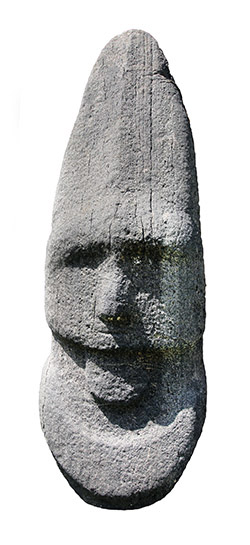 Gowe Ni'oniha - Dahana village, Gunungsitoli
Gowe Ni'oniha - Dahana village, Gunungsitoli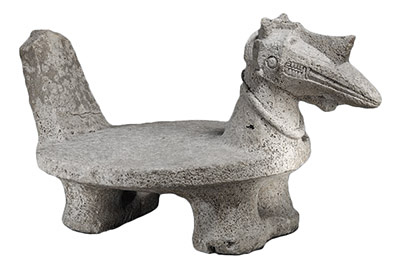
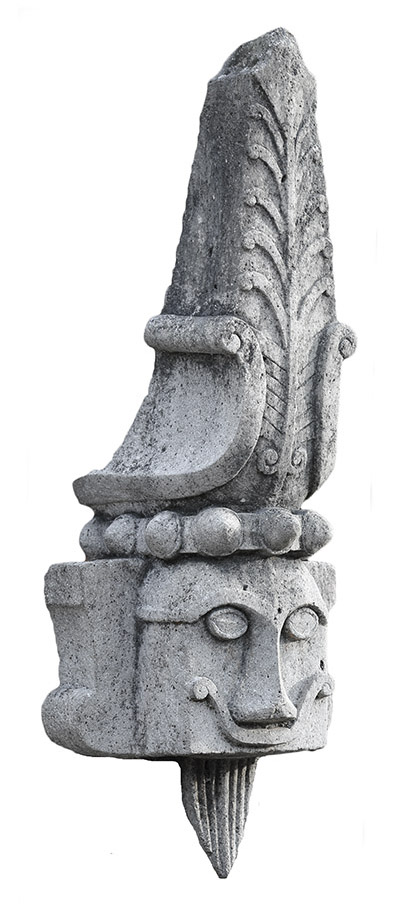 Gowe Ni'oniha - Olayama style, Bawömataluo, South Nias
Gowe Ni'oniha - Olayama style, Bawömataluo, South Nias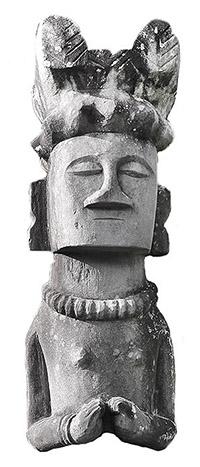 Gowe Ni'oniha - Museum Pusaka Nias
Gowe Ni'oniha - Museum Pusaka Nias 